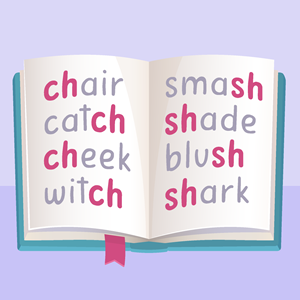Phonics Phase 3: Expansion

Phonics Phase 3: Expansion
In Year One, children continue to practise the blending and segmenting skills they learnt in Phase Two as the teacher continues to introduce new graphemes. Pupils learn the rest of the alphabet letters as well as the names of the letters and capital letters. While they still use letter sounds to 'sound out' words, they can now also use the names of the letters to spell words. They learn more exception words, become familiar with longer words, and begin to practise writing.
By the end of this phase, young readers will be familiar with over 40 phonemes including groups of letters which represent a single sound. These include mostly digraphs, or letter pairs, but also a few trigraphs (groups of three letters). They will also have begun reading longer two-syllable words.
The first set of graphemes introduced in this phase includes the four consonants j as in jump, v, as in very, w as in week, and x which is sounded out as the 'ks' sound we hear in words like box.
After this comes the final letter set which includes the last of the alphabet letters, y for the consonant sound at the beginning of words like yellow, and z as in zebra. This set also includes two digraphs, zz, which is used at the end of words like fizz and buzz, and qu, sounded-out as 'kw' as in words like queen and quick.
When children are able to recognise all the consonants, they also learn that the following pairs of consonants can be combined into digraphs to write additional sounds:
- The 'ng' sound which is spelled ng at the end of words (for example ring, song) but can also be spelled with an n as in ink.
- The soft 'sh' sound as in shop and ship.
- The hard 'ch' sound. This can be spelled ch as in rich, or tch as in catch.
- The th digraph as in thing and this.
Notice that now pupils are familiar with regular spelling patterns, they are beginning to learn some of the odd quirks of the English spelling system, where one letter or letter combination can represent different sounds and several sounds can be represented by different letters. The irregularity of English spelling begins to come into focus as children gradually learn the following fourteen vowel digraphs and trigraphs:
- oo: This stands for both the long 'o' as in boot and the short 'o' in book
- oa as in boat
- or as in horse
- air as in chair
- ear as in year
- er as in her or with a slightly different pronunciation in words like better.
- ar as in car
- ee as in week
- igh as in night
- ow as in owl
- ai as in rain
- ur as in curl
- oi as in coin
- ure as in pure and sure
Exception words introduced in Phase 3 include all the pronouns he, she, we, me, you, they and her, the possessive pronoun my, and the common verbs be, was and are.
This phase introduces a lot of new information, and some young readers may find this confusing for several possible reasons. One reason is that if the new graphemes are introduced too quickly the young learner could experience information overload. Another reason could be that the child is beginning to learn that words are not always read or spelt in the same regular and predictable manner. A third reason might be that the way a child has learnt to say words at home may not match the way he or she is being taught to read them in class.
To see if this might be a problem for your child, look at the letter-sound readings in the above list of vowel digraphs. Do they make sense to you? If not, this may be because there are differences between your accent, which your child has learnt at home, and standard English, which the phonics system is based on. If you come from the north, for example, you might use the same long 'oo' sound for both zoo and book. In other accents the 'ure' in the words pure and sure may sound quite different. A teacher using synthetic phonics needs to be sensitive to these pronunciation differences and adapt the programme if necessary.
It is important for children to master basic reading in order to succeed in later school years. So if your child seems to be finding phonics difficult, you might want to speak to his or her teacher, and may need to provide extra help at home.
Continue reading: Phonics Phase 4: Consolidation

